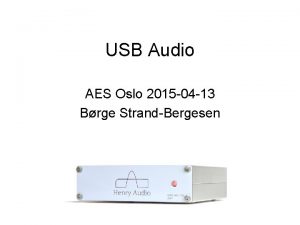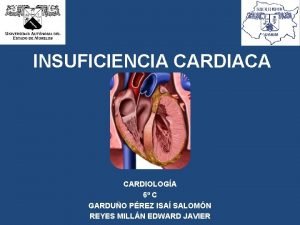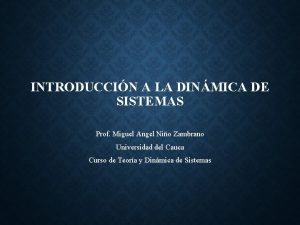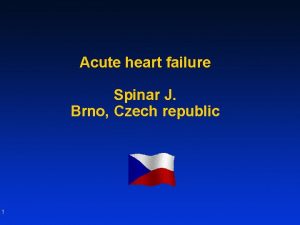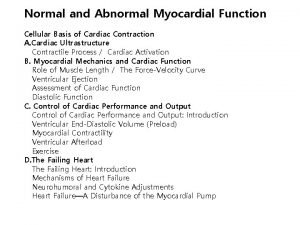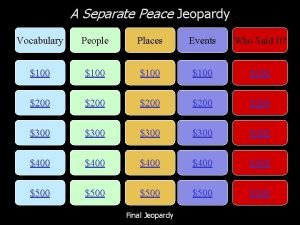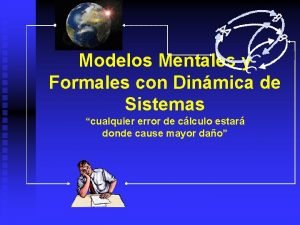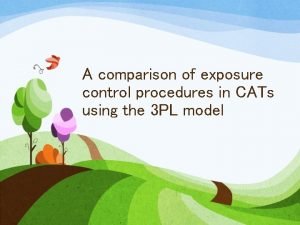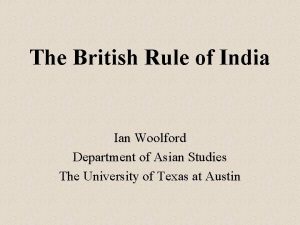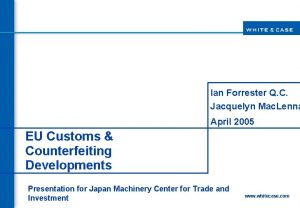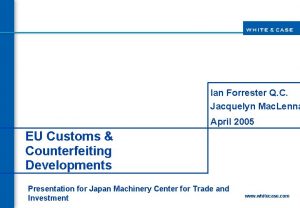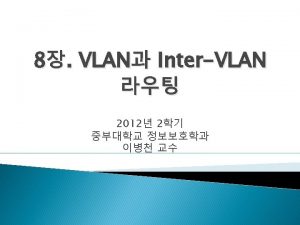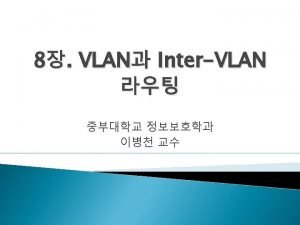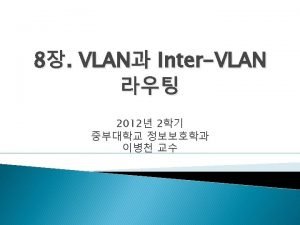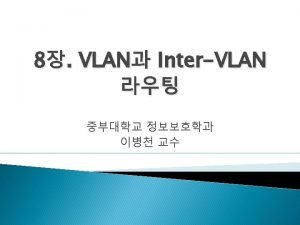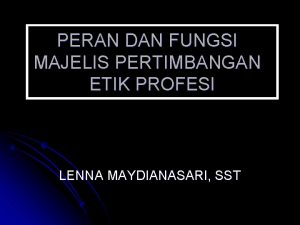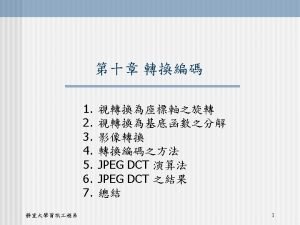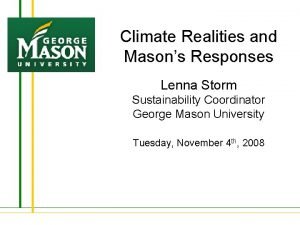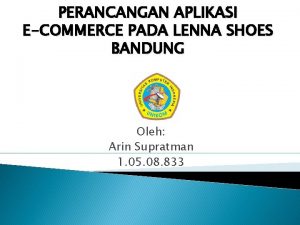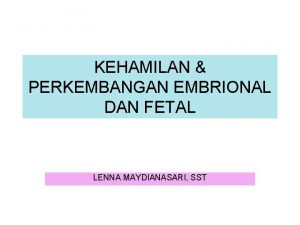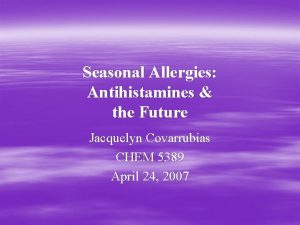Ian Forrester Q C Jacquelyn Mac Lenna April










































- Slides: 42

Ian Forrester Q. C. Jacquelyn Mac. Lenna April 2005 EU Customs & Counterfeiting Developments Presentation for Japan Machinery Center for Trade and Investment www. whitecase. com

Introduction I. II. The e. Customs vision statement and multi-annual strategic plan Modernization of the EU Customs Code Purpose, benefits, form, and timing 2. Security-related amendments to the EU Customs Code 3. Proposal on electronic transit declarations 4. Redrafting of entire EU Customs Code The proposed new EU GSP Regulation Simplification of EU Preferential Origin Rules Trends and controversies in customs classification matters The Harmonized System (HS) revision 1. III. IV. V. VI. VII. Try, try again…repayment/remission of duties and Case C-499/03 VIII. The US WTO action against the EU customs system IX. New EU legislation on counterfeiting Page 2

European Union Member States, as of 1 May 2004 (25 Member States) Page 3

I. The e. Customs vision statement and multi- annual strategic plan (MASP) §In November 2004, the European Commission (“the Commission”) distributed a e. Customs vision statement and multi-annual strategic plan (MASP). §Legal base: EC Council Resolution of 5 December 2003, endorsing the European Commission’s communication on simple and paperless environment for customs and trade. §Sets out a list of actions and timetable. Page 4

The e. Customs vision statement and multiannual strategic plan (MASP) (2) A. The e. Customs vision statement suggests that by 2008 all of the following will be adopted: § Electronic data exchange between customs offices throughout the EU for any customs procedure. § Centralized customs clearance for imports and exports (from the premises of the importer/exporter). § Introduction of the Authorized Economic Operators (AEO) concept. § Information portal for traders (i. e. access to structured information on customs and commercial rules and Page 5 procedures).

The e. Customs vision statement and multi-annual strategic plan (MASP) (3) B. The MASP proposes legal changes and simplification (2003 -2008), operational convergence (2003 -2005), and computerization of customs process: a. b. Legal changes: § The new EU Customs Code is expected to be adopted by the EC Council and the EC Parliament sometime in 2007/2008. § The Commission is drafting implementation provisions for the new Customs Code in parallel. § The new Customs Code and the implementation provisions could be applied in 2008/2009. Priority should be given to the following actions for operational convergence § Common risk management criteria. § Development of common criteria for AEO status. Page (2005) and accompanying 6 guidelines (2006). § Development of common criteria for simplified procedures available for AEOs

The e. Customs vision statement and multi-annual strategic plan (MASP) (4) C. Computerization: The Commission plans to achieve full interoperability between customs administrations in Member States by 2009: § § § Automatic Export System (AES) (2003 -2007). Automatic Import System (AIS) (2004 -2007). Exchange of risk information (2007). AEO database (2005 -2009). Coordination between customs administrations and other agencies in Member States (2004 -2007). An information portal for traders (2004 -2010). Note: Member States are very reluctant to endorse this timetable until more detailed information is provided by the Commission. Traders would like “big bang” introduction of AES and AIS (i. e. 25 Member States implementing the new system at once). The Commission considers this. Page to 7 be unrealistic.

II. Modernization of the EU Customs Code 1. Purpose, benefits, form & timing A. Purpose: § § § To introduce electronic declarations and electronic exchange of data as a rule. To simplify customs rules and procedures for economic operators. To modify the role of customs offices throughout EU Member States. To modify rights and responsibilities of traders. To tighten security on goods crossing the EU borders. To introduce new concepts in the area of customs legislation. B. Benefits: To reduce cost for businesses. § To Increase legal certainty. Page 8 market and § To allow traders to make better use of the EU single IT. §

Purpose, benefits, form & timing (2) C. Form and timing: (three separate legal texts) a. Security-related amendments to the Customs Code: • Principles already agreed upon but implementing rules still being drafted. • Target date for implementation is 2006. b. Proposal for electronic transit declarations: • Pending proposal to amend implementing provisions. • Expected date of entry into force is July 1 2005. c. Redrafting of entire Customs Code (incorporates the above two changes): • Still in pre-proposal stage. On 11 November 2004, the Commission issued the latest, 4 th-revision to the draft Customs Code. 5 th revision is currently under preparation. • On March 10 -11 DG TAXUD organized a seminar in Budapest where it started the work on the new Customs Code “in earnest”. • The Commission final proposal excepted by end of 2005. • Target date for adoption is 2007/2008. • Implementing provisions expected shortly after the new Customs Code is adopted. Page 9

2. Security-related amendments to the EU Customs Code Three main security-related amendments to the Customs Code (publication imminent but implementing provisions not yet agreed): A. Introduction of pre arrival/pre departure declarations (originally called “ 24 -hour rule”). B. Introduction of Authorized Economic Operator (AEO) status. C. Introduction of uniform risk-management criteria for customs controls. Page 10

Security-related amendments to the EU Customs Code (2) Pre arrival/pre departure declarations § Traders will provide Customs with advance information on goods brought in or out of the EU. § § The new system will provide better risk-assessment. § The implementing provisions are still under discussion and will provide specific rules on: § Quicker processing upon arrival to offset the cost of having to provide such information in advance. • the exact contents of the pre-arrival/pre-departure declaration; • the time frames for advance notice; • exceptions to the general rules; • the exchange of risk information; The following deadlines for prior declarations are anticipated: • 24 hours for goods brought in by sea, where the voyage is > 24 h. • In most other cases: 2 hours if the customs declaration is in electronic form and 4 hours if in paper. Page 11 Note: This was discussed at a seminar in Vilnius – April 13 -15 2005. § The new rules will not apply before the implementing provisions have entered into

Security-related amendments to the EU Customs Code (3) Authorized Economic Operator §Economic operators established in the EU will be able to apply for AEO status in order to obtain access to simplified rules. §AEO is granted if the operator meets a set of common criteria relating to his: • control systems; • financial solvency; • compliance record; §AEO criteria are still being adopted. §Problem: AEO status granted by Member State A will be recognized by Member State B but will not give automatic access to simplified rules in Member State B. Page 12

Security-related amendments to the EU Customs Code (4) Authorized Economic Operator (contd. ) §Member State B will accept criteria already checked by Member State A. §In some instances authorization could be limited to one or more Member States. §AEO status may be suspended or withdrawn. §Possible waiver of the requirement to be established in the EU for some AEOs, based on international agreements. (none existing at the moment; ongoing discussion with the US). Page 13

Security-related amendments to the EU Customs Code (5) Uniform risk-selection criteria for customs controls § A common computerized system, which will allow for sharing of risk-related information on import and export of goods between Member States and the Commission. § Access to sensitive information will be subject to strict rules and in line with relevant EU legislation for data protection. § Aim: To enable customs to focus on risk shipments and accelerated release of shipments by bona fide traders. Page 14

3. Proposal for electronic transit declarations §The Commission proposes that as from July 1, 2005, transit declarations should as a rule be filed electronically (in line with the aim to create e. Customs). §A transit declaration in writing would only be acceptable when either the customs authorities' computerized transit system, or the declarant's system is not functioning. §For a transitional period ending December 31, 2005, customs authorities would still be allowed to accept transit declarations in writing. §Member States wishing to use this option must inform the Commission by July 1, 2005. Page 15

4. Redrafting of entire EU Customs Code Structure of the current draft Title I: General Provisions Chapter 1: Mission, scope and basic definitions Chapter 2: Rights and obligations of persons Chapter 3: Currency conversion, time limits and simplification Title II: Factors on the basis of which import or exports duties are applied Chapter 1: Common Customs Tariff and tariff classification Chapter 2: Origin Chapter 3: Value of goods for customs purposes Title III: Guarantees and Customs Debt Chapter 1: Guarantee for potential customs debt Chapter 2: Incurrence of customs debt Chapter 3: Recovery and payment of duty, repayment and remission Page 16 Chapter 4: Extinction of customs debt

Redrafting of entire EU Customs Code (2) Structure of the current draft (contd. ) Title IV: Arrival of goods Chapter 1: Pre-arrival declaration Chapter 2: Arrival of goods Title V: General Rules on customs status and customs procedure Chapter 1: Status of goods Chapter 2: Use of the customs procedure, prohibitions and restrictions Chapter 3: Customs declaration Chapter 4: Disposal of goods Title VI: Release for free circulation Title VII: Relief from import duties Chapter 1: Returned goods Chapter 2: Products of sea-fishing and other products taken Page 17 from the sea Chapter 3: Relief on account of special circumstances

Redrafting of entire EU Customs Code (3) Structure of the current draft (contd. ) Title VIII: Special Procedures Chapter 1: General provisions Chapter 2: Transit Chapter 3: Storage Chapter 4: Specific Use Chapter 5: Processing Title IX: Departure of goods Chapter 1: Goods leaving the customs territory Chapter 2: Export Chapter 3: Relief from export duty on account of special circumstances Title X: Final Provisions Chapter 1: Customs Code Committee Page 18 Chapter 2: Other final provisions

Redrafting of entire EU Customs Code (4) Some of the most important changes are: §Centralized customs clearance: The new Customs Code should introduce centralized customs clearance through a “single window/one stop shop” concept, based on electronic exchange of data: • Importers/exporters will be able to lodge summary/customs declarations in electronic form from their premises regardless of where the goods enter or leave the EU customs territory. • Collection and repayment/remission of import duties will be handled by the customs office where the trader is established. • Efforts so far have largely failed: - Present Customs Code allows for the use of “Single European Authorisations” (SEA). SEA allows certain customs obligations in other Member States to be handled from another Member State (e. g. Swedish operator is able to customs clear and pay customs debt for imports from third countries directly into the Netherlands through the Swedish – not Dutch – customs authorities). - SEA requires bilateral agreements between the customs authorities of the Member States involved. As 25% the customs revenue stays with the collecting Member State, many Member States are reluctant to enter into SEAs as they fear they will loose customs revenue. - At present there are no true EU-wide SEAs in place. At most, existing SEAs cover only a few Member States. - Page The Commission has suggested that the 25% share system is 19 reviewed to avoid it hampering the introduction of centralized clearance.

Redrafting of entire EU Customs Code (5) Some of the most important changes are: (contd. ) §E-customs: Electronic declarations and exchange of data will become the principal means of communication between economic operators and customs administration, and between administrations. This principle will be introduced soon together with the amendments for pre arrival/pre departure declarations, and the proposal for transit declarations. §Harmonization of administrative penalties: The Commission views this as a major step forward to create a level playing field. At present, the situation differs from one Member Step to another. The framework harmonization should cover a list of infringements, minimum and maximum fines, and aggravating and extenuating circumstances. §Customs representation - customs agents: Member States will no longer be allowed to restrict representation to customs agents established on their territory. §Decisions by Customs authorities - time frame and form – Customs will be Page rules 20 obliged to issue decisions on the application of customs within short period of time (2 months). However they may exceed this time period “where they are unable to comply with it”.

Redrafting of entire EU Customs Code (6) Some of the most important changes are: (contd. ) §Decisions on the classification of a product: The present Binding Tariff Information (BTI) will be replaced by “classification decisions”. The new Customs Code will formally oblige the recipient of a classification decision to use it, even if he is not happy with the classification code it prescribes. The validity of classification decisions will be limited to 3 years (from 6 today). §Appeal possibilities: • Initially - before the customs authorities or another body, which may be a judicial authority or another equivalent specialized body designated for that purpose by the Member State. • Subsequently – before an independent body, which may be a judicial authority or another equivalent specialized body according to the provisions in force in that Member State. §Declarant's place of establishment can be outside the EU – a person established outside the EU will be able to make a customs declaration. The declarant will have to lodge a guarantee to avoid abuse. Page 21

Redrafting of entire EU Customs Code (7) Important other changes concern E-customs Centralized customs clearance Greater scope for Community-wide decisions Smoother changes to implementing provisions Harmonization of administrative penalties Customs Representation - customs agents Decisions by Customs – timeframe and form Decisions on the classification of a product Decisions on the origin of a product Decisions on other matters Appeal possibilities –harmonization Currency conversion New preferential origin Valuation Customs debt Place at which customs debt is incurred Guarantees also covering VAT and excise Debtor(s) in the case of non-compliance Time limit for entry in the accounts – audits Repayment of interest by Member States in the case of late repayment harmonized Deferment of payment – abolition of fees Repayment or remission of duties for defective goods Postal traffic – narrower definition Free zones Supporting documents must be “available” Declarant’s place of establishment can be outside the EU Partial examination of goods Simplified declaration External transit Storage Temporary admission Inward processing suspension system Page 22 Export procedure

III. The proposed new EU GSP (adoption blocked) §Product scope: • Generally wider compared to the current regime. In certain sectors – narrower. • For products under chapters 84, 85, 87, 90 (machinery, electronics, transport equipment, etc) no changes in the product scope have been made. • The new GSP regulation refers to product sections as defined by the Common Customs Tariff – 21 Section, most of which cover several chapters (e. g. Section XVI – chapters 84 and 85). §Beneficiary countries: • The list of beneficiary countries is the same as under the current system. • A beneficiary country can be removed from the list if: • - For 3 years in a row, the country has been classified by the World Bank as a highincome economy, and - The 5 largest sections of its GSP-covered imports into the EU represent less than 75% of the total GSP-covered imports from all beneficiary countries into the EU. A beneficiary country can also be removed from the Page list if 23 it benefits from a trade agreement with the EU.

The proposed new EU GSP (2) GSP rates & GSP Plus §GSP rates: • The standard GSP rate for products listed in Annex II as non-sensitive is 0%. • For sensitive products –reduction in the normal duty by 3. 5 percentage points (for textile and clothing – reduction by 20%). • The calculated duty is rounded down to the first decimal point. §GSP Plus: • Is a “special incentive arrangement for sustainable development and good governance”. • Replaces/combines the current special incentive regimes. • Is offered to “vulnerable countries”, which meet special criteria. • Offers eligible countries 0% duty for all products listed in Annex II (with Page 24 some minor exclusions).

The proposed new EU GSP (3) Graduation & Rules of origin §Graduation • A country will lose preferential treatment for products in a certain section when the country’s imports of products under this section into the EU exceed 15% of imports of these products from all GSP-beneficiary countries in 3 consecutive years. • Result: various countries currently graduated for certain sectors will regain benefits (e. g. Malaysia and Thailand for chapters 84 & 85). §GSP rules of origin • The draft regulation does not envisage any changes to the current rules of origin; • However, the Commission recently adopted its strategy on simplified rules of origin, which will affect the GSP system in the future (target date is 2006 for GSP; later for other preferential rules). Page 25

The proposed new EU GSP (4) Status of legislation §The Commission proposal was discussed in the EC Council on 16 March 2005 but no agreement was reached (textile graduation thresholds very controversial). §The legislation was later on discussed in COREPER (April 13) but again no agreement was reached. §EU Trade Ministers to discuss “textiles” on their meeting on 24 April 2005. The outcome of the discussions to decide how the GSP proposal will progress. §Council and Commission determined to meet the “new” deadline – 1 July, 2005. §The Commission had proposed that the GSP regulation should apply retroactively as of 1 April 2005 even if adopted after that date. In light of the Page 26 remain. latest developments, it is not clear whether this provision will

IV. Simplification of Preferential Origin Rules §On March 16, the Commission adopted its long-awaited strategy for simplifying EU preferential origin rules. §The current preferential origin rules are rather complex. The goods are deemed to have the origin of the place where they have undergone “sufficient processing”. §“Sufficient processing” varies from product to product and can take the form of: • Change in tariff heading; • Value added; • Specific process rule; Page 27

Simplification of Preferential Origin Rules (2) §The new proposed rules envisage a simple value added criterion. §The Commission has not yet announced thresholds but observes that threshold will differ among product sectors. §There might be additional origin rules for certain “risky” product sectors (e. g. textiles, agriculture, etc). §Regional cumulation will continue to apply with value added threshold within the region. §The Commission proposes change in the proof of origin, no longer involving the issue of origin certificates by the authorities. The new system will involve prior registration by the authorities of the exporting country of exporters who would then make their own statements of origin. ØThe Commission will begin the simplification of the preferential origin rules with the adaptation of the GSP origin rules. The Commission hopes that the Page 28 new GSP rules can enter into effect in 2006.

V. Trends and controversies in customs classification matters § Classification of products for use with ADP machines as consumer electronic or other products (e. g. flat screens, ink cartridges) – classification under 8471 to be the exception; § Binding Tariff Information (BTI): not providing complete legal certainty to the holder (e. g. revocation by issuing authorities possible where their interpretation changes); § Commission getting firmer on insisting that classification matters agreed in the Nomenclature Committee are implemented and no conflicting BTI is issued (plasma screens); § BTI system will be amended during the modernization of Page 29 the Customs Code, e. g. three year validity instead of six years

VI. The Harmonized System (HS) revision §Major revision of the Harmonized System (HS) agreed in 2004. §Implementation on January 1, 2007 into EU Combined Nomenclature (CN). §Updating to technical progress and trade evolution, make structure more logical. §Should not lead to higher tariffs. Page 30

The Harmonized System (HS) revision (2) Key changes in Section XVI - chapter 84 §Separate new heading for machines and apparatus of a kind used solely or principally for the manufacture of semiconductor materials or flat panel displays (HS 8486). §New Note 5(D) to Chapter 84 explicitly excluding from 8471, when presented separately: • printers, copying machines and fax machines (belong in 8443); • apparatus for the transmission or reception of voice, images or other data, including in wired or wireless networks (LAN, WAN) (belong in 8517); • loudspeakers and microphones; • TV cameras, digital cameras and video camera recorders; §Removal of distinction between digital, analogue and hybrid ADP machines (8471). Page 31

The Harmonized System (HS) revision (3) Key changes in Section XVI - chapter 85 §Explicit exclusion of machinery and apparatus for the manufacture of semiconductor materials (new Note 1(c) to Chapter 85). §Amendments to HS 8523 regarding discs and tapes, now including solid-state nonvolatile storage devices as well as smart cards, and new Note 4 to Chapter 85 with definition of “smart cards” and “solid-state non-volatile storage devices”. §Amendments to Note 5 (renumbered Note 8) to Chapter 85 relating to the definitions of the various kinds of electronic ICs, and allowing classification in 8523 for items which also fit in 8541 or 8542 but have the specific function attached to 8523. §Creation of new subheading for “connectors for optical fibers, optical fiber bundles or cables” (853670) and definition of these items in new Note 6 to Chapter 85. §Explicit inclusion of LAN/WAN apparatus in 8517. §Restructuring of HS 8528 (monitors/projectors and reception apparatus for TV): will also explicitly covers monitors and projectors for ADP machines, but provides subheadings to distinguish these from monitors and projectors not for use with ADP machines. §Restructuring of HS 8542 (electronic integrated circuits): simpler structure, divided into electronic integrated circuits (further subdivided into processors/controllers, memories, Page 32 amplifiers and other) and parts.

VII. Try, try again. . . Peter Biegi…v. Commission, Case C-499/03 P §On March 3, 2005 the Court of Justice (ECJ) issued a decision, which increases hopes for importers to obtain repayment or remission of customs duties when they have acted in good faith, in particular when the EU legislation is ambiguous. §The German tariff schedule was not clear whether import licenses were needed in order for importers to benefit from a duty-free quota for imports of poultry meat. The traders, acting in good faith, had inquired and received the confirmation of the German Ministry of Finance that licenses were in fact not needed. §The German authorities subsequently decided that licenses were required for that product and requested post-clearing payment for the various shipments. §The Commission, and subsequently the Court of First Instance (CFI) on appeal, ruled post-clearance recovery was due as the rules were not complex and there was doubt as to whether parties were acting in good faith. §Finally, the ECJ overturned the CFI’s decision and ordered the Commission to pay the costs. §BUT it took around 8 years from the original claim by Customs until the ECJ issued its decision. Page 33 §The decision shows that despite the difficulty in proving “act in good faith” it may still be worthwhile to appeal customs decisions rejecting repayment or remission of duties.

VIII. The US complaint against the EU’s customs system §The US filed a complaint with the WTO in September 2004. §The US requested a WTO panel to examine the legality of EC customs legislation – January 2005. §The US has a number of complaints as regards: • The lack of uniformity in customs procedures among Member States. • The absence of procedures for prompt EU-wide review of customs matters. §The following countries have requested to join the consultations: Japan, Australia, Argentina, Brazil, India, the Separate Customs Territory of Taiwan, Penghu, Kinmen and Matsu. Ø On 22 March, 2005, the WTO agreed to set up a panel. §EU regrets the US action. The EU had explained to the US its plans on customs and modernization of the Customs Code. EU thought the US was sympathetic and was surprised that the US requested a panel. §Timing: • 9 months for the panel; • 90 days for appeal; • 15 months for the implementation of the appellate body decision; Page 34

IX. New developments in the area of counterfeiting §Two ways to fight counterfeiting in the EU: • Customs action - at the EU border level by Customs. • Within the EU by enforcement authorities. §The Commission has adopted new legislation at both levels: • Customs action: - Regulation 1383/2003 on customs action against counterfeit and pirated goods. - Regulation 1891/2004 implementing Regulation 1383/2003 on customs action against counterfeit and pirated goods; Note: Both regulations apply as of 1 July 2004. • Enforcement of intellectual property rights inside the EU: - Directive 2004/48/EC on the enforcement of intellectual property rights. Page 35

New developments in the area of counterfeiting (2) Customs action §Extension of the scope of protection to cover additional IPRs (e. g. geographical indications, designations of origin). §Extended scope of the "ex officio" procedure, which allows customs to act without a prior application for action. §No application fees and security payments for right holders requesting customs action - right holders instead need to provide a declaration accepting liability towards the targeted persons if customs action is discontinued due to an omission by the right holder or if no infringement was found. §Definition and harmonization of the information to be included in the application for Customs action. §Electronic applications are encouraged. Page 36

New developments in the area of counterfeiting (3) Customs action (contd. ) §Customs to decide on the application within 30 days (previously no deadline). §Customs can take action within 1 year following the granting of the application. §More information to right holders. §Detailed rules on sampling – right holders can be given samples but only for analysis in order to be able to pursue the procedure. §Shorter timeframes for the release of perishable goods (3 days instead of 10 to 20). §Simplified procedures for destruction of counterfeit goods in certain instances: • Upon right holder's request • Unless declarant/owner/holder objects • Destruction at the right holder’s expense • Sampling (evidence) §Checks of travelers if larger-scale trafficking is suspected. Page 37

New developments in the area of counterfeiting (4) IPR enforcement within the EU Directive 2004/48/EC: § Covers the following IP rights: copyright and related rights, sui generis right of a database maker, rights of the creator of the topographies of a semiconductor product, trademark rights, design rights, patent rights, including rights derived from supplementary protection certificated, geographical indications, utility model rights, plant variety rights, trade names (if considered exclusive property rights in the national law concerned). § Ensures consistent protection of IPRs across the EU by bringing national legislation on civil sanctions and remedies in line with “best practice” (i. e. more favorable EU law or national legislation can be used by right holders). § Complements the Counterfeit regulation – acts as a safety net to catch third country products. Page 38

New developments in the area of counterfeiting (5) IPR enforcement within the EU (contd. ) §Includes procedures regarding evidence • protection of evidence • §Right of information: Judicial authorities may order certain persons to reveal names and whereabouts of people involved in distribution of illegal goods. §Provisional and precautionary measures (e. g. injunctions and seizure, blocking of bank accounts). §Remedies available to right holders include: Destruction • Recall or permanent removal from the market of counterfeit goods • Financial compensation • Injunctions • Page 39

New developments in the area of counterfeiting (6) IPR enforcement within the EU (contd. ) §Damages: • Compensatory damages (actual prejudice). • At least the amount of royalties/fees normally due. §Legal cost. §Publication of decisions. §Timing: Published 30 April 2004. To be implemented by Member States in 2 -years time. Page 40

CONCLUSIONS § Entering a new world of customs procedures and customs rules in the EU § Still have EU making the rules and the Member States responsible for enforcing the rules - but Member States no longer have unlimited freedom § Time for companies to review their customs practices, analyse how to take account of the likely benefits of new rules § For the moment – uncertainty § For IPR holders – situation has improved Page 41

Contacts Ian S. Forrester, Q. C. Iforrester@whitecase. co m Jacquelyn Mac. Lennan White&Case, Brussels Wetstraat 62 rue de la Loi 1040 Brussels Tel +32 (0)2 219 16 20 Fax +32 (0)2 219 16 26 jmaclennan@whitecase. com Page 42
 Haar transform
Haar transform Lenna
Lenna Jacquelyn elkington
Jacquelyn elkington The real macbeth king of scotland
The real macbeth king of scotland Mac mac o kok dac
Mac mac o kok dac Susan bidel
Susan bidel Insuficiencia cardiaca clasificacion
Insuficiencia cardiaca clasificacion Andrew hogan forrester
Andrew hogan forrester Forrester wave email marketing vendors 2017
Forrester wave email marketing vendors 2017 Forrester cross channel attribution
Forrester cross channel attribution Forrester vendor landscape umia
Forrester vendor landscape umia Forrester wave loyalty program service providers
Forrester wave loyalty program service providers Forrester
Forrester Diagrama de bucle causal
Diagrama de bucle causal Forrester enterprise service management
Forrester enterprise service management Dobutamine mechanism of action
Dobutamine mechanism of action Dr jill forrester
Dr jill forrester Renee murphy forrester
Renee murphy forrester Forrester wave data integration
Forrester wave data integration Merritt maxim forrester
Merritt maxim forrester Forrester location intelligence
Forrester location intelligence Big data fabric
Big data fabric Forrester
Forrester Forrester wave email marketing vendors 2017
Forrester wave email marketing vendors 2017 Forrester omnichannel banking
Forrester omnichannel banking Country manager russia
Country manager russia Diagrama de forrester
Diagrama de forrester Dr kim forrester
Dr kim forrester What is real-time interaction management
What is real-time interaction management Forrester wave 2017 rpa
Forrester wave 2017 rpa Forrester classification
Forrester classification Dr martine forrester
Dr martine forrester Daryan reinoso
Daryan reinoso Forrester wave wcm
Forrester wave wcm Forrester customer journey mapping
Forrester customer journey mapping Forrester wave data governance
Forrester wave data governance A separate peace vocabulary
A separate peace vocabulary Modelos mentales y formales
Modelos mentales y formales Ian tibbetts
Ian tibbetts Thinking history.co.uk
Thinking history.co.uk Ian hembry
Ian hembry Ian boersma
Ian boersma Devilfish in egyptian waters cartoon
Devilfish in egyptian waters cartoon




